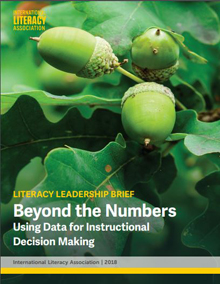
Rather than being shaped by accountability policies and requirements, student learning goals and needs should be the driving force behind what data are collected and how they are used.
When centered on students’ unique needs, data can serve as a portrait, a highlighter, and a springboard to enhance student learning and inform instructional decision making, according to ILA’s latest brief, Beyond the Numbers: Using Data for Instructional Decision Making.
Educators should view students as key sources of their own learning data, asserts ILA.
“We’re moving away from the idea that data equal obligatory test scores and percentages,” says ILA Executive Director Marcie Craig Post. “The most powerful sources of data are the unique experiences students have in the classroom.”
Snapshot data, such as test scores, are often used incorrectly to categorize or label students by their abilities, according to ILA. Data should include a wide range of information, such as formative assessments, student engagement observations, student oral responses, and knowledge of students’ backgrounds, to provide a fuller portrait of students’ strengths and needed areas of support.
Examining discrepancies and patterns across multiple forms of data can illuminate equity concerns and allow for a more truthful picture of student learning. When analysis leads to uncertainty about next steps or solutions, data act as a springboard, prompting further inquiry and investigation.
The brief concludes with five actionable steps for using data to support instructional improvements.
Access the full brief here.
Alina O'Donnell is the communications strategist at ILA and the editor of Literacy Daily.